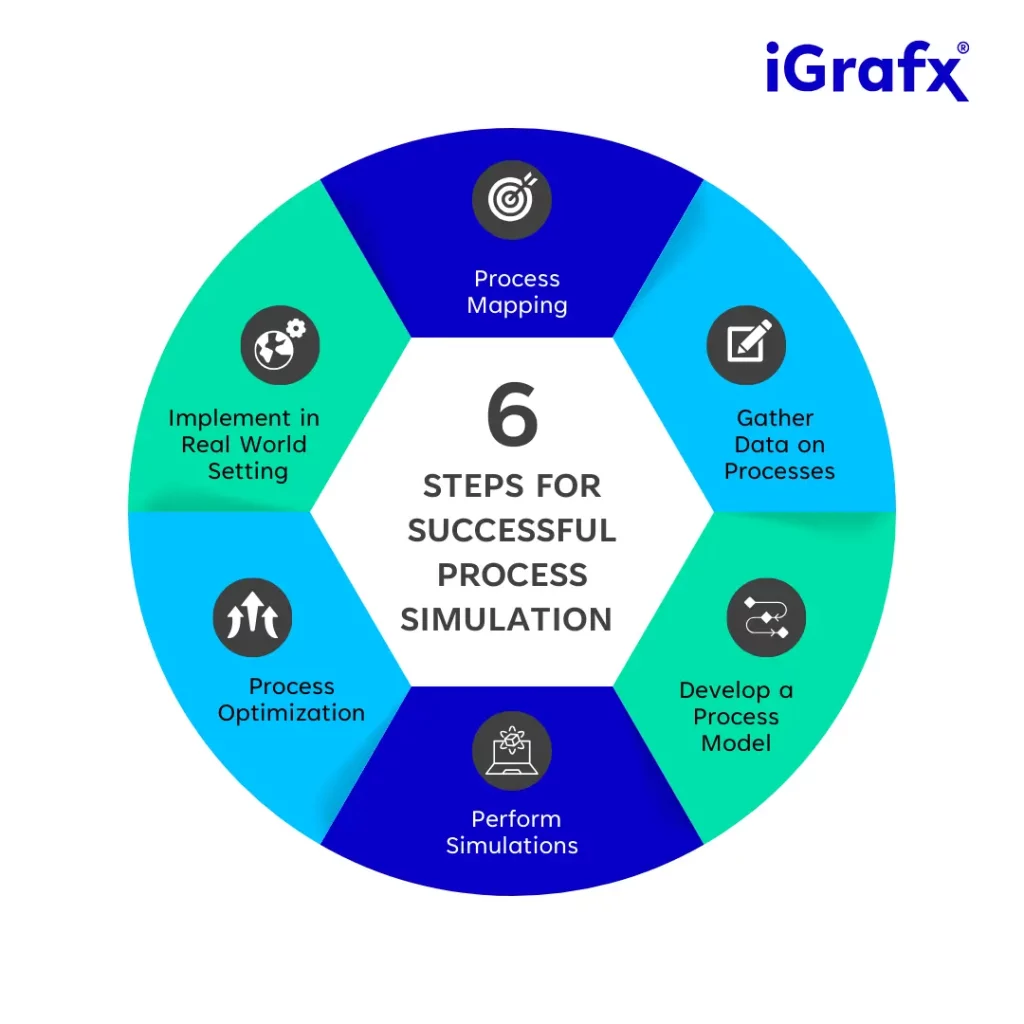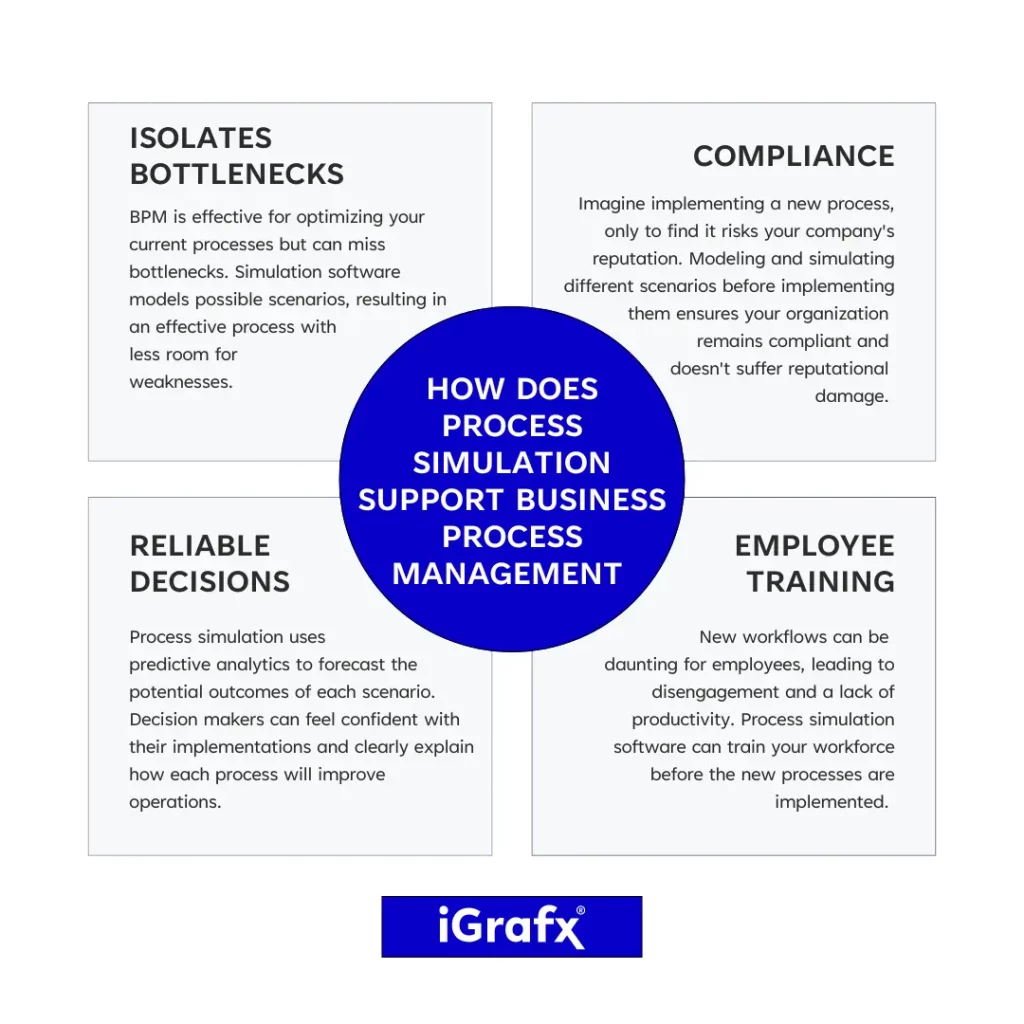Ineffiziente Prozesse können Unternehmen bis zu 1,3 Millionen US-Dollar pro Jahr kosten, wobei der Widerstand gegen Veränderungen und veraltete Arbeitsabläufe die Haupthindernisse sind, um der Zeit voraus zu sein. Laut einer Studie des American Productivity & Quality Center (APQC) erzielen Unternehmen, die Prozessverbesserungspläne priorisieren, durchschnittliche Kosteneinsparungen von 20 bis 30 % und eine deutliche Reduzierung von Fehlern und Defekten. Prozessmanagement ist ein bewährter Weg, um ineffiziente Arbeitsabläufe durch digitale Transformation zu identifizieren und zu mildern.
Die Prozesssimulation ist eine Schlüsselkomponente jeder Geschäftsprozessmanagementstrategie und ermöglicht es den wichtigsten Stakeholdern, “Was-wäre-wenn”-Szenarien zu testen und vollständige Klarheit über jede einzelne Entscheidung zu gewinnen.
In diesem Blog erfahren Sie mehr über die Grundlagen der Prozesssimulation, ihre potenziellen Vorteile und darüber, wie Sie sie in Ihre Prozessmanagementstrategie integrieren können.
Was ist Prozesssimulation?
Bei der Prozesssimulation werden Arbeitsabläufe anhand digitaler Darstellungen der Abläufe Ihres Unternehmens analysiert. Es ermöglicht Unternehmen, “Was-wäre-wenn”-Szenarien zu testen und zu sehen, wie sich Änderungen auf ihr Geschäft auswirken, indem sie verbesserungswürdige Bereiche identifizieren, bevor sie Investitionen tätigen
Das Ergebnis? Effiziente Prozesse, optimierte Arbeitsabläufe und datengesteuerte Veränderungen, mit denen sich das Unternehmen leichter verbinden lässt.
Warum ist das wichtig?
Jede Änderung an einem Geschäftsprozess hat Auswirkungen, und die Simulation ermöglicht es Unternehmen, ihre Auswirkungen vorherzusagen.
Bei Prozesssimulationssoftware geht es nicht nur um Effizienzoptimierung und die Beseitigung von Engpässen. Es identifiziert auch die potenziellen Risiken jedes Prozesses und stellt sicher, dass Entscheidungsträger die Vorschriften einhalten können.
Die Implementierung neuer Workflows, die die Geschäftsziele nicht unterstützen, kann zu Ressourcenverschwendung und Produktivitätsverlusten führen. Die Prozesssimulation stellt sicher, dass Prozessverbesserungen tatsächlich zu einem ROI führen, der mit den Geschäftszielen übereinstimmt, was sie zu einer wichtigen Strategie für zukunftsorientierte Unternehmen macht.
Das Ziel der Prozesssimulation
Jede Führungskraft muss operative Entscheidungen treffen, um sicherzustellen, dass ihr Unternehmen wettbewerbsfähig bleibt und einen optimierten Ansatz für komplexe Prozesse hat. Prozessmanagement ermöglicht es Unternehmen, Arbeitsabläufe zu optimieren und mehr Effizienz zu erreichen.
Ohne Prozesssimulation wäre Prozessmanagement so, als würde man mit verbundenen Augen an einen unbekannten Ort gehen. Sie kennen die Auswirkungen eines neuen Prozesses erst, wenn Sie ihn implementieren – es sei denn, Sie simulieren die potenziellen Ergebnisse.
Und das ist das Ziel der Prozesssimulation: Neue Arbeitsabläufe zu testen oder bestehende zu optimieren und Klarheit darüber zu gewinnen, wie sie mit den Zielen Ihres Unternehmens übereinstimmen.
Die Vorteile der Prozesssimulation
Die Prozesssimulation bietet große Vorteile für Unternehmen, die wettbewerbsfähig bleiben und einen nahtlosen Betrieb erreichen wollen. Wenn Entscheidungsträger in die Lage versetzt werden, Arbeitsabläufe zu rationalisieren und die Mitarbeitererfahrung zu transformieren, führt dies zu einem synergetischen Umfeld, das den Erfolg fördert.
Lassen Sie uns einige der wichtigsten Vorteile der Prozesssimulation untersuchen.
Kosten senken
Unternehmen können viel Geld verlieren, wenn sie Prozesse in einer realen Umgebung testen. Die Simulation von Änderungen in einer virtuellen Umgebung senkt jedoch die Kosten und stellt sicher, dass sich nichts auf das Endergebnis Ihres Unternehmens auswirkt.
Wenn die Simulation keine optimalen Ergebnisse liefert, können Sie sie optimieren, bis Sie die beste Lösung gefunden haben.
Risikomanagement
In einer hart umkämpften Geschäftslandschaft ist die Risikobereitschaft ein wesentlicher Bestandteil für Wachstum und Wohlstand (Forbes). ). Es gibt einen großen Unterschied zwischen dem Werfen der Vorsicht in den Wind und dem Eingehen eines kalkulierten Risikos. Dieser Unterschied liegt oft in der Prozesssimulation.
Indem Sie Ihre Arbeitsabläufe im Vorfeld testen, können Sie Unterbrechungen vermeiden und Komplikationen reduzieren.
Entscheidungsfindung
Das Prozessmanagement gibt detaillierte Einblicke in die Produktivität und Effizienz eines Unternehmens. Durch die Abbildung verschiedener Arbeitsabläufe können Entscheidungsträger die Prozessentwicklung priorisieren und Entscheidungen treffen, die die Unternehmensziele unterstützen.
Durch die Eliminierung von Rätselraten können sich Unternehmen auf die Zukunft vorbereiten und klare Strategien entwickeln.
Nachhaltigkeit
In einer zunehmend umweltbewussten Gesellschaft müssen Unternehmen zeigen, dass sie den Planeten respektieren. Untersuchungen von McKinsey zeigen, dass über 70 % der Verbraucher Wert auf Nachhaltigkeit legen, und viele werden mehr für umweltfreundliche Produkte bezahlen.
Die Abbildung Ihrer Prozesse ermöglicht es Ihnen, deren Auswirkungen auf die Umwelt zu bewerten und zu bewerten, wo Sie Ressourcen verschwenden. Die Durchführung einer dynamischen Simulation kann zu einem umweltfreundlicheren Betrieb führen und den Ruf Ihres Unternehmens verbessern.
Sechs Schritte zur erfolgreichen Prozesssimulation
Die Prozesssimulation besteht aus sechs Schritten, die jeweils für absolute Klarheit sorgen und Raum für Fehler beseitigen. Und so funktioniert es:
Schritt 1: Prozessabbildung
Der erste Schritt besteht darin, eine visuelle Darstellung jedes Schritts im Prozess zu erstellen, einschließlich Aufgaben, Schritten und Entscheidungspunkten. Einfach ausgedrückt: Die Prozessabbildung reduziert jeden Prozess, um Ineffizienzen aufzudecken und den wichtigsten Stakeholdern einen vollständigen Überblick zu bieten.
Eine Software für das Geschäftsprozessmanagement erstellt Flussdiagramme oder Diagramme, um jeden Schritt des Prozesses hervorzuheben, sodass keine manuelle Aufgabenidentifizierung und -zuordnung erforderlich ist.
Schritt 2: Sammeln von Daten
In der Phase der Datenerfassung werden Informationen zu jedem Prozess gesammelt, einschließlich seiner Kosten, Dauer und Ressourcenverfügbarkeit. Sobald Sie über diese Daten verfügen, können Sie sie für Baseline-Metriken verwenden und Parameter für die Prozessmodellierung erstellen. Die Erstellung einer genauen Ausgangsbasis ist absolut entscheidend, um der Simulationsausgabe vertrauen zu können, daher wird empfohlen, Prozess-Mining zu verwenden, um Daten auf objektive Weise zu sammeln.
Schritt 3: Entwicklung des Vorgehensmodells
Die Software verwendet die Prozesslandkarte und die Daten, um ein digitales statistisches Modell zu erstellen, das zeigt, wie jede Aufgabe, Ressource und Entscheidung miteinander verbunden ist. Es handelt sich im Wesentlichen um eine Blaupause, die den Basisprozess identifiziert und die Simulation verschiedener Szenarien ermöglicht.
Schritt 4: Simulationen
Sobald Sie verstanden haben, wie sich vorhandene Prozesse auf die betriebliche Effizienz auswirken können, können Sie das Basismodell ändern, um verschiedene Szenarien zu testen. Dies kann bedeuten, mehr Ressourcen zuzuweisen oder zu entfernen, Prozessabläufe durch Hinzufügen oder Entfernen von Schritten neu zu gestalten oder die Dauer jeder Aufgabe zu ändern.
Die Durchführung von Simulationsläufen ermöglicht es Ihnen, Engpässe zu isolieren, Bereiche für den Einsatz neuer Technologien wie Automatisierung oder KI zu identifizieren und eine Strategie zur Beseitigung von Ineffizienzen zu entwickeln.
Schritt 5: Prozessoptimierung
Prozesssimulation und -optimierung gehen Hand in Hand, denn Sie können jeden Prozess optimieren, sobald Sie Erkenntnisse gesammelt haben. Denken Sie daran, dass es in dieser Phase darum geht, Ihre Simulationen zu verfeinern und erneut auszuführen, um die besten Ergebnisse zu erzielen.
Schritt 6: Umsetzung
Nachdem Sie Simulationen durchgeführt und die Ergebnisse ausgewertet haben, können Sie sie in Ihrer realen Umgebung implementieren. Ein kontinuierliches Monitoring ermöglicht es Entscheidungsträgern, Engpässe zu identifizieren und unterstützt die Optimierung in Echtzeit. Die Anpassung jedes Prozesses fördert die kontinuierliche Verbesserung.
Wann sollte die Prozesssimulation eingesetzt werden?
Die Prozesssimulation ist ein wertvolles Werkzeug für alle Unternehmen, vom Kleinbetrieb bis zum internationalen Konzern. Wenn Sie jedoch noch keine Erfahrung in der Simulation von Prozessen haben, kann es eine Herausforderung sein, herauszufinden, wo Sie mit dem Einsatz von Simulationssoftware beginnen sollen. Die folgenden Szenarien eignen sich hervorragend als Anwendungsfälle für die Prozesssimulation:
- Sie möchten verfahrenstechnische Änderungen implementieren, sind sich aber nicht sicher, wie sie sich auf reale Anwendungen auswirken werden.
- Es gibt erhebliche Ressourcenbeschränkungen, was bedeutet, dass es unmöglich ist, verschiedene Prozesse auszuprobieren. Durch den Aufbau des simulierten Prozesses in einen digitalen Zwilling können Sie Optimierungen simulieren, ohne Ihre Ressourcen zu verschwenden.
- Es ist unmöglich, Ihre aktuellen Prozesse zu stoppen, wenn Sie neue testen möchten. Unternehmen, die sich auf kontinuierliche Fertigung konzentrieren, können beispielsweise ihre Produktionslinien nicht herunterfahren, um einen neuen Workflow auszuprobieren.
- Die Geschäftsleitung und interne Stakeholder lassen Prozessänderungen erst zu, wenn sie genaue Daten und eine Kosten-Nutzen-Analyse erhalten haben.
Wie Prozesssimulation das Geschäftsprozessmanagement unterstützt
Traditionelles Geschäftsprozessmanagement stützt sich auf historische Daten und frühere Erfahrungen, was von Vorteil sein kann, aber auch Grenzen hat. Die Integration von Prozesssimulationen erstellt eine digitale Kopie jeder Aufgabe und jedes Workflows, mit der Sie verschiedene Szenarien testen können.
So kann die Simulation von Prozessen das Geschäftsprozessmanagement unterstützen:
- Isolierung von Engpässen: BPM ist effektiv für die Optimierung Ihrer aktuellen Prozesse, kann aber Engpässe übersehen. Simulationssoftware modelliert mögliche Szenarien, was zu einem effektiven Prozess mit weniger Spielraum für Schwachstellen führt.
- Compliance: Stellen Sie sich vor, Sie implementieren einen neuen Prozess, nur um festzustellen, dass er den Ruf Ihres Unternehmens gefährdet. Die Modellierung und Simulation verschiedener Szenarien vor deren Implementierung stellt sicher, dass Ihr Unternehmen konform bleibt und keinen Reputationsschaden erleidet.
- Zuverlässige Entscheidungen: Die Prozesssimulation nutzt prädiktive Analysen, um die potenziellen Ergebnisse jedes Szenarios vorherzusagen. Entscheidungsträger können sich bei ihren Implementierungen sicher fühlen und klar erklären, wie jeder Prozess den Betrieb verbessert.
- Mitarbeiterschulung: Neue Arbeitsabläufe können für die Mitarbeiter entmutigend sein und zu Unzufriedenheit und mangelnder Produktivität führen. Prozesssimulationssoftware kann Ihre Mitarbeiter schulen, bevor die neuen Prozesse implementiert werden.
Beispiele für Prozesssimulation in der Praxis
Die Anwendungsfälle der Prozesssimulation sind sehr vielfältig. Von der Fertigungsindustrie über das Gesundheitswesen bis hin zum Projektmanagement können alle Branchen Simulationen in die Geschäftsprozessmanagementstrategie integrieren.
Gesundheitswesen
Die Gesundheitsbranche ist immer sehr gefragt, hat aber ständig mit Lieferproblemen zu kämpfen. Durch die Prozesssimulation können Patientenflüsse optimiert und systemische Schwachstellen identifiziert werden.
Es kann auch verschiedene Personalbestände testen, die positiven Auswirkungen der Automatisierung vorhersagen und Gesundheitsdiensten helfen, ein nahtloses Patientenerlebnis zu bieten.
Fertigung
Unternehmen im Fertigungssektor setzen häufig Prozesssimulationssoftware ein, um Produktionslinien zu optimieren. Entscheidungsträger können Szenarien ausprobieren, die die Logistik verbessern, indem sie Engpässe verstehen und Material- und Produktströme bewerten.
So kann beispielsweise eine Prozessanlage Simulationssoftware verwenden, um den Ressourcenverbrauch zu bewerten und Lösungen zu finden, die die Nachhaltigkeit fördern.
Projektmanagement
Große Unternehmen haben oft Schwierigkeiten mit dem Projektmanagement, aber die Simulation optimiert den Ist-Prozess, um bessere Ergebnisse zu erzielen.
Wenn ein Projektmanager beispielsweise Arbeitsabläufe verbessern möchte, kann er “Was-wäre-wenn”-Szenarien testen, einschließlich Verzögerungen, nicht verfügbarer Ressourcen und der Einführung neuer Strategien.
Einführung von Prozesssimulationssoftware in Ihre BPM-Strategie
Prozesssimulationssoftware stützt sich auf Data Science und Algorithmen, um ein digitales Modell Ihres Prozesses zu erstellen und die Ergebnisse verschiedener Szenarien vorherzusagen. Es identifiziert potenzielle Engpässe und ermöglicht es Teams, jeden Prozess oder jede Aufgabe innerhalb dieses Prozesses zu optimieren, um optimale Ergebnisse zu erzielen.
Die fortschrittlichsten Softwarelösungen für die Prozesssimulation bieten punktgenaue Genauigkeit und ermöglichen es Ihnen, einen digitalen Zwilling Ihrer gesamten realen Organisation zu erstellen.
Der technologische Fortschritt bedeutet, dass sich Unternehmen keine Gedanken über die Integration verschiedener Prozessabbildungs-, Simulations- und Management-Tools machen müssen. Process360 Live ist eine End-to-End-Plattform, die alle Bereiche des Geschäftsprozessmanagements unterstützt.
Die drei Phasen der Plattform helfen Ihnen, ineffiziente Prozesse in optimierte Arbeitsabläufe umzuwandeln, die Ihre Mitarbeiter motivieren und die Kunden zufrieden stellen.
- Entdecken: Verwenden Sie Tools zur Prozesserkennung und -abbildung, um detaillierte Einblicke in Ihre aktuellen Prozesse zu erhalten.
- Design: Schaffen Sie eine bessere Zukunft für Ihr Unternehmen, indem Sie Simulationen durchführen und herausfinden, wie sich diese auf das Endergebnis auswirken.
- Optimieren: Verwenden Sie Process360 Live, um jeden Prozess zu optimieren und zu überwachen, um bessere Ergebnisse zu erzielen.
Sind Sie bereit, Ihr Unternehmen mit Prozesssimulation zu transformieren?
Die Unternehmenstransformation ist ein fortlaufender Prozess, aber die Prozesssimulation vereinfacht alles. Sobald Sie die Auswirkungen der einzelnen Prozesse verstanden haben, ist es einfacher, die Einhaltung der Vorschriften sicherzustellen und von kontinuierlichen Kosteneinsparungen zu profitieren.
Wenn Sie sehen möchten, wie Prozesssimulationssoftware Ihr Unternehmen seinen Zielen näher bringen kann, buchen Sie bitte eine kostenlose Demo von Process360 Live. Sie können auch eine kostenlose Testversion nutzen , ohne in die Software investieren zu müssen.
Häufig gestellte Fragen
Kann ich Prozesssimulationen in Python ausführen?
Ja, das können Sie. Python ist eine Open-Source-Lösung, die eine Allzwecksprache verwendet. Wenn Sie mit der Python-Programmierung vertraut sind und die Feinheiten der Prozesssimulation verstehen, ist es möglich, sie zu verwenden.
Eine spezielle Software macht die Prozesssimulation jedoch auch für jeden zugänglich, der keine umfangreichen Programmierkenntnisse hat.
Was passiert mit dem Geschäftsprozessmanagement ohne Prozesssimulation?
BPM ist nach wie vor eine effektive Strategie, aber es fehlt die Klarheit, die die Prozesssimulation bietet. Da die Software historische Daten und frühere Erfahrungen berücksichtigt, ist sie nicht so effektiv darin, die potenziellen Ergebnisse neuer Implementierungen vorherzusagen.
Die Integration der Prozesssimulation in Ihre weitreichende BPM-Strategie bietet Ihnen volle Klarheit und ermöglicht es Ihnen, die mit der Einführung neuer Prozesse verbundenen Risiken zu reduzieren.




